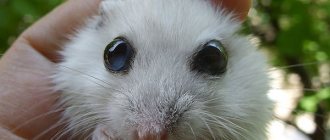Causes of eye diseases in hamsters
Hamsters often have various infectious diseases, as well as eye diseases acquired with age. If you notice that your pet cannot open its eyes, you need to determine the reason. There is no need to delay this; it is better to treat the hamster right away to avoid complications in the future.
Causes:
- Allergic reactions. From exotic fruits and treats, your hamster is likely to develop allergies and tearing. Also, an allergy in a hamster can arise from the special products you used to disinfect the cage; these products contain chemicals.
- Unsanitary conditions. This is the most common cause of eye disease in rodents. If you do not frequently change the filler and bedding in your pet’s cage, then harmful microorganisms will begin to multiply there very quickly. At the same time, the rodent often hides in the litter and can easily catch an infection.
- Injuries. A hamster can get injured in the eyes very easily. It can prick your eye on sharp sawdust or straw, and a piece of the filler can get under your eyelid. Also, if you notice that your hamster's cheek is very inflamed, this may also be the reason why the hamster's eyes will not open.
- Weak immunity. Eye problems in a rodent can appear together with other diseases: tuberculosis, pneumonia and viral respiratory diseases.
In older individuals, due to age-related changes, white spots may appear on the eyes.
Signs of eye diseases
How to recognize that your pet has eye problems?
It is advisable to pay attention to the condition of your animal every day so as not to miss the moment of illness.
You need to pay attention when you notice:
- wet eyes;
- swelling of the eyelids;
- discharge of mucus from the eyes;
- the hamster cannot open one or both eyes;
- hair falls out on the eyelid;
- the pupil of the eye turned white.
In older individuals, the pupil may become cloudy, and other signs can occur in a rodent of any age; they are often symptoms of the disease.
All eye diseases can be divided into those that were formed as a result of injury and those that were caused by trauma. that arose as a result of infectious diseases.
How to treat eye diseases
Usually the owner notices the problem of eyeball prolapse when the symptoms become more pronounced. Sometimes in such circumstances the affected eye is difficult to save, but you should fight for the second and, possibly, for the life of the rodent.
It is best to take a sick hamster to a veterinarian as soon as possible so that he can make the correct diagnosis, prescribe antibiotics, or perform other procedures and operations. In some cases, treatment may last up to 2 weeks or longer depending on the severity of the lesion.
Important! Do not use antibiotics that are in your home medicine cabinet. Hamsters are different from humans and not only require different doses, but also metabolize medications differently than humans.
Usually the doctor prescribes 0.3% eye drops “Gentamicin”, “Albucid”. The solution should be administered to rodents according to the instructions: usually 3-4 drops per day. But it is advisable not to self-medicate, so as not to aggravate the situation.
At home, you can use a solution of boric acid (1 teaspoon per 100 ml of boiled and cooled water) to wash the eyes, cleanse crusts and relieve irritation. Using a dropper, apply drops to your eyes 2-3 times a day. If there are no signs of recovery within 2-3 days, you should contact your veterinarian, as more serious health problems may arise.
To clean wounds and soak away crusts on the eyelids, you can use a saline solution, which is distilled salt water and has almost the same structure as tears.
Here's how to make your own saline solution:
- 250 ml of distilled or boiled and cooled tap water;
- 2.5 g table salt;
- 2.5 g baking soda.
The prepared product should be stored in a clean glass jar for no longer than 24 hours. When carrying out hygienic procedures, you need to dip a clean cotton pad or swab into the solution and wipe the eye in the direction from the inner corner to the outer. Use clean material for each wash. To prevent the hamster from transferring the infection from one eye to the other while washing, both need to be treated, even if signs of the disease are noticed in only one.
Try not to get your pet wet - a wet hamster takes a long time to dry and can easily get sick. If necessary, specialists perform eye removal operations under short general anesthesia.
Also find out what to do if your hamster dies.
Hamster eye injury
Hamsters are quite active, running a lot and moving around and outside the cage, so they can often get injured.
If your pet just has an eye injury, it is not easy to immediately recognize the severity and how exactly he received it. At first, the rodent will squint its eye and will not allow you to examine it. If your pet is in pain, then its behavior may change; it will be twitchy, scared, not friendly, and may go into the house and not make contact with the person.
If the cornea is damaged, the pet may develop an infection, the eye may become inflamed, and purulent discharge may appear.
To examine an injured eye if the eyelid is stuck together, it must first be opened.
This must be done carefully, you cannot open it by force, you must soak it in boiled water or a special saline solution. Each eye should be washed and wiped with separate cotton wool rolls; a fresh one should be used for each eye. When the eye heals, a white spot may appear on the cornea - this is normal.
It happens that when examining and treating the eye, you can understand that it is not the eye itself that is injured, but the eyelid. If the eyelid is injured, it must be treated and smeared with tetracycline ointment.
If after an injury a hamster has a red spot on its eye, this means that a drop of blood has coagulated in the cornea of the eye. If the eye is in place and there are no visible serious injuries, it is difficult to determine how severe the injury is.
Conjunctivitis
Conjunctivitis is an inflammation of the mucous membrane. In general, this eye disease is quite common, and it can occur not only in rodents. If this disease appears, it often occurs in both eyes at once.
The causes of this disease include mechanical damage to the mucous membrane, infectious diseases, allergic reactions, for example, to disinfectants and cleaning agents, dust, dirt from linings and fillers.
If the inflammation occurs due to an allergic reaction, the discharge from the eyes will be clear. If conjunctivitis is the result of an infection, the discharge will be cloudy. From cloudy discharge, it will turn into purulent in the future.
In rodents, other infectious diseases usually appear along with conjunctivitis, most often this happens when the owner rarely cleans the cage and changes the lining. If the cage is rarely cleaned, the hamsters' eyes will fester regularly.
Inflammation is treated in the same way as eye injuries. First of all, in order not to provoke the appearance of the disease again, it is necessary to remove the lining from the cage; it is better to lay paper instead. This is necessary to maintain hygiene standards.
Afterwards, you need to wash and clean with disinfectants the entire cage and objects for the hamster to sleep and play with. After cleaning and treatment, the cage with the hamster must be removed from a bright place and the sun; after such an illness, the light will cause discomfort.
Injuries and inflammatory processes and their symptoms
In inflammatory processes associated with pathologies or injuries, the following symptoms occur:
- edema;
- inability to open eyes, squinting, trembling eyelids;
- liquid or purulent discharge, tearing;
- formation of a cone or barley;
- redness of the damaged area;
- hair loss on the eyelids and around the eyes.
The presence of these manifestations indicates infectious or age-related pathologies, and sometimes mechanical damage. In the latter case, infection with pathogens may occur later if the animal was not treated in time or the pet’s immune system is weakened.
When infected, the general condition further worsens. The pet refuses water and food, vomits, and digestion of food is disrupted.
Corneal damage
Damage to the cornea occurs more often in mobile, active animals. In most cases, the condition is associated with mechanical trauma.
Corneal damage often occurs due to mechanical trauma.
Shards, dust, sand, filler, etc. can get into your eyes. Sometimes the damage is caused by a scratch. In rare cases, the integrity of the cornea is compromised due to infectious pathologies, contact with chemicals and congenital pathologies.
If the pet's cornea is damaged, visual acuity decreases. The problematic eye is closed or squinted, the eyelids tremble. Sensitivity to irritants is increased: the pet hides in a bright room and suffers from severe lacrimation. The general well-being of the animal worsens. The mucous membranes turn red.
If damage to the cornea is associated with a foreign object, there is a chance that the latter will be removed without third-party intervention along with the discharge. Otherwise, you need to visit a veterinarian. After removing foreign bodies, the eyelids are washed with antibacterial agents and anti-inflammatory drugs are used.
Blepharitis
Blepharitis is an inflammatory process that primarily affects the eyelid rather than the eye. However, these are neighboring tissues, so as the disease develops, the organs of vision also suffer. Blepharitis develops due to many reasons. For example, due to bacterial infections, incorrect use of medications, inflammatory dermatological pathologies, gastrointestinal problems, etc.
Blepharitis is accompanied by purulent inflammation of the eyelids.
Blepharitis is characterized by changes in the color of the eyelids. They may darken, but more often they turn red due to inflammation. Sometimes the skin on them peels off. The animal suffers from itching. It scratches your eyes and can damage them. Another problem is weakening of local immunity and possible infection. Bumps often form on inflamed eyelids.
Blepharitis of the eye is usually treated with antibiotics. Additionally, it is important to maintain cleanliness in the cage and provide your pet with time. This will prevent the progression of the disease and infection of the tissues.
Abscess
Another name for an abscess is stye. This is not an independent disease, but a symptom. It can occur against the background of blepharitis, weakened immunity with concomitant infection, etc. When an abscess appears, the appearance of the eye changes, and a difference in size becomes visible due to the tumor. The temperature of neighboring tissues rises as a result of inflammation.
With an abscess, itching occurs, and sometimes mucous discharge appears. In rare cases, barley goes away on its own, but more often it requires veterinary intervention. Recovery occurs after the capsule is freed from pus.
Blunt trauma
A rodent can receive blunt trauma as a result of a fall. Sometimes an animal is accidentally crushed while walking. As a result, massive damage to all structures of the visual organs occurs. It is accompanied by severe hemorrhage. In case of injury, only 1 eye or both may be affected. A few hours after the injury occurs, the blood settles and the tissues turn red. The entry of blood particles into the vitreous body causes vision loss.
In case of injury, damage to one eye is typical.
If a blunt injury occurs, the animal should be taken to a veterinarian as quickly as possible. It is impossible to make a prognosis and cure your pet at home on your own. You can only provide first aid if you cannot visit the clinic in the near future. Apply a cool cloth soaked in saline solution to the damaged area and use antibacterial ointment. The latter prevents the cornea from drying out in case of severe swelling, if the animal cannot blink.
Conjunctivitis
Conjunctivitis is the most common eye disease found in hamsters. The pathology is characterized by bilateral inflammation, although this is an optional sign. The disease develops due to mechanical trauma, irritation from chemicals, infections, allergies, etc. The animal can become ill when in contact with household products, such as floor cleaning solution or hairspray. Filler, dust or sand can provoke inflammation. Poor quality litter injures mucous membranes.
With conjunctivitis, the animal's eyes begin to water.
Symptoms help indirectly determine the cause. In the initial stages, if the disease is caused by mechanical irritation or allergies, the discharge from the eyes will be clear. If there is an infection, the liquid becomes cloudy and later acquires a yellow or greenish tint. The animal can become infected with pathogens during the process if it is not given timely assistance.
Other symptoms include itching, pain, photophobia and watery eyes. The eyeball enlarges, the eyelids swell. To eliminate symptoms, anti-inflammatory and antibacterial agents are used.
Bacterial infections
Bacterial infection can be either an independent or concomitant disease. Most often, conjunctivitis develops as a result of the penetration of pathogens. An animal can become infected if it has a weakened immune system, is injured, has a damaged cornea, etc.
Bacteria multiply quickly, especially if the damage is deep. Without help, pathogens increasingly penetrate tissues. Subsequently, the bacteria, along with the bloodstream, are spread to all organs and systems, which can lead to the death of the animal. In case of deep infection, it is necessary to resort to surgical intervention, including removal of the eye, in order to save the hamster’s life.











